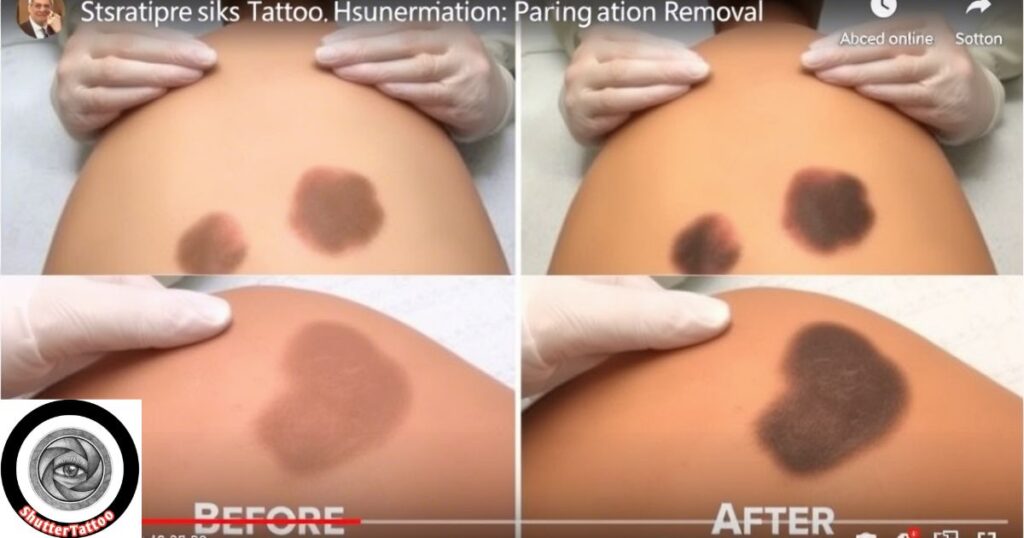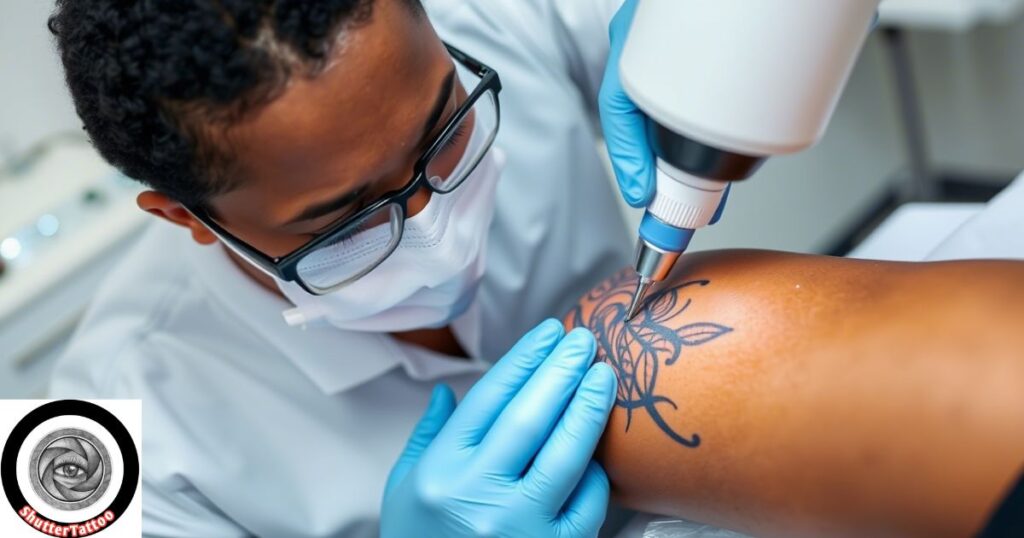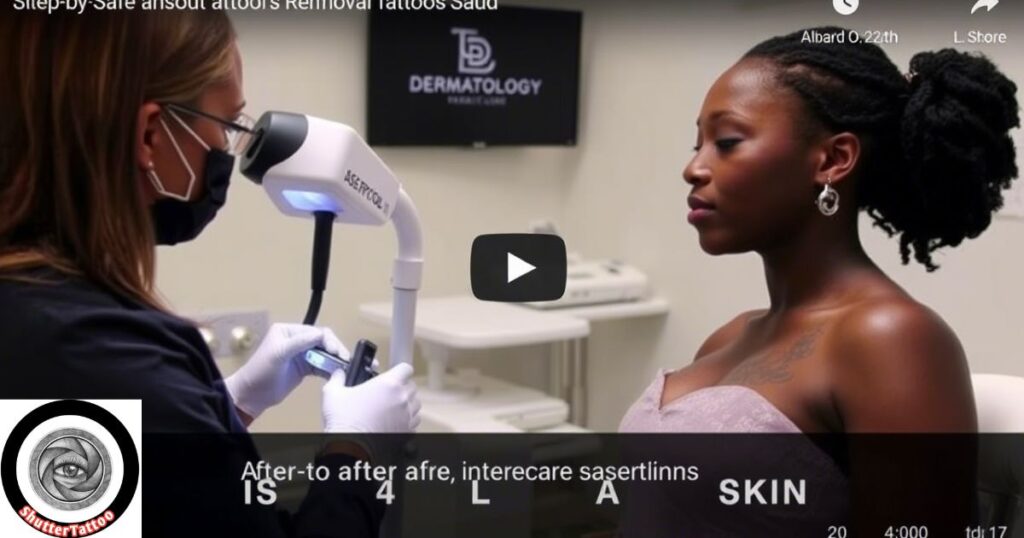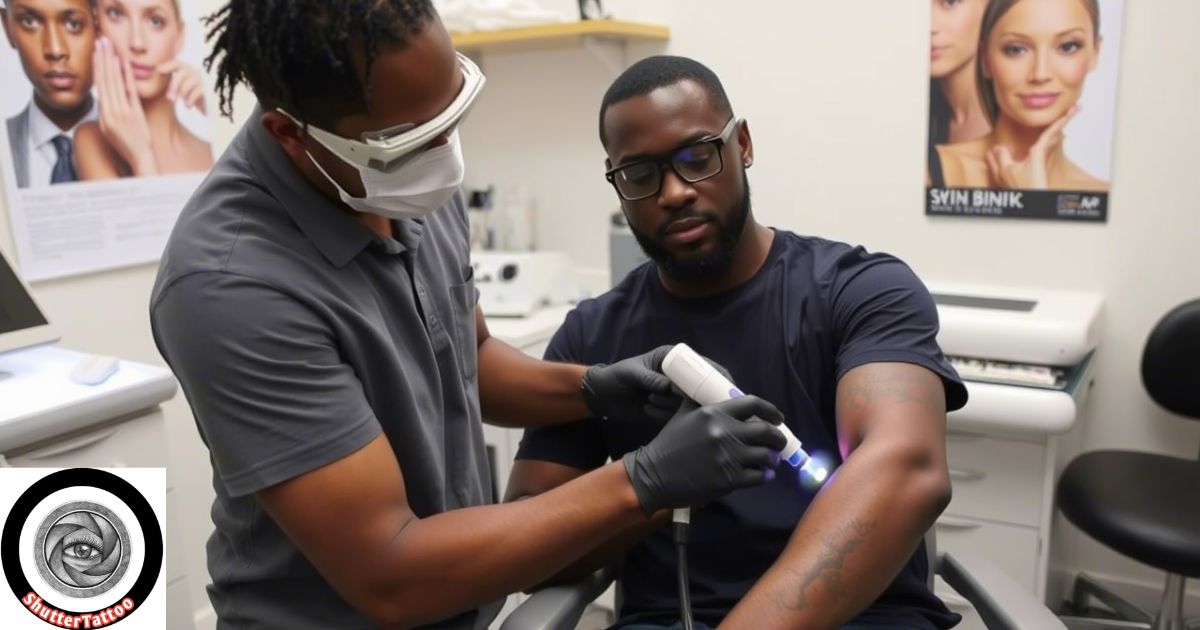Tattoo Removal for Black Skin presents unique challenges due to higher melanin levels, which can increase the risk of hyperpigmentation and scarring during removal procedures. This comprehensive guide explores safe and effective tattoo removal solutions tailored for darker skin tones, providing insights into advanced techniques, potential risks, and essential aftercare practices.
Whether you’re considering laser treatments or alternative methods, this article offers valuable information to help you make informed decisions and achieve optimal results.
Why Tattoo Removal on Black Skin Requires Special Care
Removing tattoos from black skin necessitates specialized care due to the unique characteristics of melanin-rich skin. Understanding these nuances is crucial for safe and effective tattoo removal.
Understanding the Unique Challenges of Melanin-Rich Skin
Melanin, the pigment responsible for skin color, absorbs laser energy during tattoo removal. In darker skin tones, this absorption can lead to complications such as hyperpigmentation (darkening), hypopigmentation (lightening), or scarring if not properly managed. Therefore, selecting appropriate laser settings and techniques is vital to minimize these risks.
How Skin Tone Affects Laser Tattoo Removal Outcomes
The success of laser tattoo removal is influenced by skin tone. Darker skin requires careful calibration of laser parameters to target tattoo ink effectively while preserving surrounding tissue. Utilizing lasers with specific wavelengths, like the Nd:YAG laser at 1064 nm, is often preferred for treating tattoos on black skin due to its lower melanin absorption, reducing potential side effects.
Risks to Avoid: Hyperpigmentation, Hypopigmentation, and Scarring

Potential risks during tattoo removal on black skin include:
- Hyperpigmentation: Darkening of the skin post-treatment.
- Hypopigmentation: Lightening of the skin in treated areas.
- Scarring: Permanent marks resulting from improper healing.
How Does Tattoo Removal Work on Dark Skin Tones?
Tattoo removal on dark skin involves breaking down ink particles while preserving the skin’s natural pigment.
The Science Behind Laser Tattoo Removal for Black Skin
Lasers emit specific wavelengths of light that are absorbed by tattoo ink particles, causing them to fragment. The body’s immune system then gradually eliminates these fragments. For black skin, lasers like the Q-switched Nd:YAG at 1064 nm are preferred due to their precision and reduced risk of pigmentary changes.
Why Not All Lasers Are Created Equal: Pico vs. Q-Switched Lasers
While both Pico and Q-switched lasers are used for tattoo removal, their effectiveness varies:
- Q-Switched Lasers: Utilize nanosecond pulses to break down ink particles.
- Picosecond Lasers: Deliver shorter, picosecond pulses, potentially leading to faster ink fragmentation and fewer sessions.
Non-Laser Alternatives: Are They Safe for Dark Skin?
Non-laser methods, such as chemical peels or dermabrasion, pose higher risks for individuals with dark skin, including scarring and pigmentary changes. Laser treatments remain the safest and most effective option for tattoo removal on black skin.
Choosing the Right Tattoo Removal Specialist for Black Skin

Selecting a qualified specialist is paramount to ensure safe and effective treatment.
What to Look for in a Tattoo Removal Clinic
When choosing a clinic, consider the following:
- Experience: Practitioners should have a proven track record with dark skin tones.
- Technology: Availability of appropriate lasers, such as the Nd:YAG 1064 nm.
- Consultation Services: Offering personalized treatment plans and thorough consultations.
Questions to Ask Your Specialist Before Starting Treatment
Prepare for your consultation with these questions:
- What laser technology do you use for dark skin?
- How many sessions do you anticipate for my tattoo?
- What aftercare protocols do you recommend?
Why Experience with Dark Skin Tones Matters
Experienced specialists understand the intricacies of treating melanin-rich skin, reducing the likelihood of adverse effects and ensuring optimal results.
Step-by-Step Guide to Safe Tattoo Removal for Black Skin

Embarking on tattoo removal requires informed preparation and understanding.
Consultation: What to Expect During Your First Visit
During your initial consultation:
- Assessment: Evaluation of your tattoo’s size, color, and location.
- Skin Analysis: Determination of your skin type and suitability for laser treatment.
- Discussion: Explanation of the procedure, expected outcomes, and potential risks.
The Tattoo Removal Process: From Pre-Treatment to Aftercare
The removal process involves:
- Pre-Treatment: Avoid sun exposure and discontinue certain skincare products.
- During Treatment: Protective eyewear is provided; the laser is applied to the tattooed area.
- Post-Treatment: Follow aftercare instructions, including keeping the area clean and protected.
How Many Sessions Will You Need? A Realistic Timeline
The number of sessions varies based on factors like tattoo complexity and individual skin response. On average, multiple sessions spaced several weeks apart are necessary to achieve desired results.
Understanding the specific needs of black skin in tattoo removal is essential for safe and effective outcomes. By selecting experienced professionals and appropriate technologies, individuals can navigate the process with confidence and achieve optimal results.
Aftercare Tips for Tattoo Removal on Dark Skin
Proper aftercare is crucial for minimizing complications such as hyperpigmentation and scarring after tattoo removal on dark skin.
How to Prevent Hyperpigmentation and Scarring Post-Treatment
To reduce the risk of hyperpigmentation and scarring:
- Sun Protection: Avoid direct sun exposure for at least two weeks post-treatment. Apply a broad-spectrum sunscreen with SPF 30 or higher to shield the treated area.
- Gentle Cleansing: Clean the area daily with mild soap and water to prevent infection.
- Moisturization: Use non-scented moisturizers like petroleum jelly to keep the skin hydrated and promote healing.
- Avoid Picking or Scratching: Refrain from touching scabs or blisters to prevent scarring.
The Best Skincare Products for Healing After Tattoo Removal
Selecting appropriate skincare products aids in recovery:
- Petroleum Jelly: Keeps the area moist and supports skin regeneration.
- Fragrance-Free Moisturizers: Reduce irritation and maintain hydration.
- High-SPF Sunscreen: Protects against UV rays, preventing pigmentation changes.
What to Avoid During the Recovery Process
During recovery, steer clear of:
- Direct Sunlight: Exposure can lead to pigmentation issues.
- Tight Clothing: May irritate the treated area.
- Submerging in Water: Avoid swimming pools, hot tubs, or baths until fully healed.
- Harsh Skincare Products: Exclude exfoliants and active ingredients that could irritate the skin.
Read This Blog: Women Sleeve Tattoo Ideas: The Ultimate Guide to Feminine Arm Art (2025)
Common Myths About Tattoo Removal on Black Skin Debunked
Misconceptions about tattoo removal on black skin can deter individuals from seeking treatment.
Myth 1: Tattoo Removal Doesn’t Work on Dark Skin
Fact: Tattoo removal is effective on dark skin when performed by experienced professionals using appropriate laser technology.
Myth 2: All Lasers Are Safe for Melanin-Rich Skin
Fact: Not all lasers are suitable for darker skin tones. Lasers like the Q-switched Nd:YAG at 1064 nm are preferred due to their safety and efficacy.
Myth 3: Tattoo Removal Always Leaves Scars
Fact: With proper technique and aftercare, scarring is uncommon. Choosing skilled practitioners and adhering to aftercare instructions significantly reduces this risk.
Success Stories: Real People Share Their Tattoo Removal Journeys
Hearing from others can provide encouragement and insight.
Before and After: Inspiring Transformations on Black Skin
Many individuals with dark skin have successfully removed tattoos, achieving clear skin without adverse effects. For example, Removery showcases several cases where clients with darker skin tones have undergone tattoo removal with excellent results.
Tips from Those Who’ve Successfully Removed Their Tattoos
Insights from successful individuals include:
- Patience: Understanding that multiple sessions may be necessary.
- Diligent Aftercare: Following all post-treatment guidelines to ensure optimal healing.
- Choosing Experienced Professionals: Selecting specialists familiar with dark skin tattoo removal.
FAQ
Is Tattoo Removal Painful for Dark Skin Tones?
The procedure may cause discomfort, often described as a rubber band snapping against the skin. Topical anesthetics can be applied to minimize pain.
How Much Does Tattoo Removal Cost for Black Skin?
Costs vary based on factors like tattoo size, color, and location. Consultation with a qualified specialist will provide a personalized estimate.
Can You Remove Colored Tattoos from Dark Skin?
Yes, colored tattoos can be removed from dark skin. However, certain colors may require more sessions or specific laser types. Consulting with an experienced professional is essential to determine the best approach.
Conclusion
Embarking on tattoo removal for black skin requires informed decisions and specialized care to ensure safe and effective outcomes. By understanding the unique challenges of melanin-rich skin, selecting experienced professionals, and adhering to proper aftercare, you can achieve optimal results.
Ready to take the next step? Consult with a qualified tattoo removal specialist to explore personalized solutions tailored to your skin type. Remember, with the right approach, clear skin is attainable.

